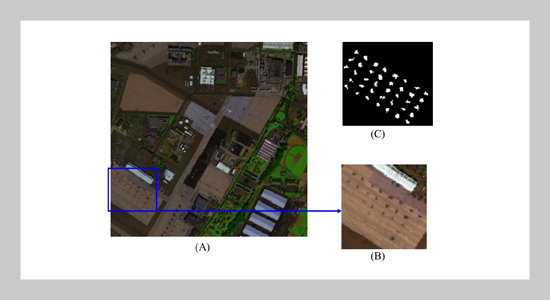REFERENCES
- [1] Reed, I.S., and Yu, X. (1990) A daptive multiple-band CFAR detection of an optical pattern with unknown spectral distribution, Acoustics, Speech and Signal Processing, IEEE Transactionson 38, 1760-1770.
- [2] Zhao, R., Du B., and Zhang, L.P. (2017) Hyperspectral anomaly detection via a sparsity score estimation framework, IEEE Transactions On Geoscience And Remote Sensing 55, 3208-3222.
- [3] Maryam, I. (2017) RX anomaly detector with rectified background, IEEE Geoscience and Remote Sensing Letters 14, 1313-1317.
- [4] Chang, C.I., and Chiang, S.S. (2002) Anomaly detection and classification for hyperspectral imagery, IEEE Trans. Geosci. Remote Sens 40, 1314-1325.
- [5] Guo, Q.D., Zhang, B., and Ran, Q. (2014) Weighted-RXD and linear filter-based RXD: improving background statistics estimation for anomaly detection in hyperspectral imagery, IEEE J. Sel. Topics Appl. Earth Observ. Remote Sens 7, 2351-2366.
- [6] Molero, J.M., Paz, A., and Garzón, E.M. (2011) Fast anomaly detection in hyperspectral images with RX method on heterogeneous Clusters, J Supercomput. 58, 411-419.
- [7] Schaum, A.P. (2007) Hyperspectral anom- aly detection beyond RX, Proc. SPIE 6565: 656502.
- [8] Kwon, H., and Nasrabad, N.M. (2005) Kernel RX-algorithm:a nonlinear anomaly detector for hyperspectral imagery, IEEE Transactions on Geoscience and Remote Sensing 43, 388-397.
- [9] Zhao, C.H.,Li, J.W.,and Meng, M.L. (2017) A weighted spatial-spectral kernel rx algorit- hm and efficient implementation on GPUs, Sensors 441, 1-19.
- [10] Banerjee, A., Burlina, P., and Diehl, C. (2006) A support vector method for anomaly detection in hyperspectral imagery, IEEE Trans. Geoscience and Remote Sensing 44, 2282-2291.
- [11] Yuan, Z.Z., Sun, H., and Ji, K.F. (2014) Local sparsity divergence for hyperspectral anomaly detection, IEEE Geoscience and Remote Sensing Letters 11, 1697-1701.
- [12] Li, J.Y., Zhang, H.Y., and Zhang, L.P. (2015) Hyperspectral anomaly detection by the use of background joint sparse representation, IEEE Journal of Selected Topics in Applied Earth Observations and Remote Sensing 8, 2523-2532.
- [13] Pan, L., Li, H.C., and Deng, Y.J. (2017) Hyperspectral dime- nsionality reduction by tensor sparse and low-rank graph-based discriminant analysis, Remote Sesing 452, 3208-3222.
- [14] Xu, Y., Wu, Z.B., and Li, J. (2016) Anomaly detection in hyperspectral images based on low-rank and sparse representation, IEEE Transactions on Geoscience and Remote Sensing 54, 1990-2000.
- [15]Noiboar, A., and Cohen, I. (2007) Anomaly detection based on wavelet domain garch random field modeling, IEEE Transactions on Geoscience and Remote Sensing 45, 1361-1373.
- [16] Zhang, Y., Zhang, J.P., and Jin, M. (2000) Adaptive subspace decomposition and classification for hyperspectral images, Chinese Journal of Electronics 9, 82-88.
- [17] Sheng, Z., Xie, S.Q., and Pan, C.Y. (2001) Probability theory and mathematical statistics, Zhejiang University Press 3, 20-35.
- [18] Li, S.S., Zhang, B., and Gao, L.R. (2010) Research of hyperspectral target detection algorithms based on variance minimum, Acta Optica Sinica 30, 2116- 2122 .
- [19] Zhao, C.H., LI, J., and Mei, F. (2011) A kernel weighted rx algorithm for anomaly detection in hyperspectral imagery, J.Infrared Millim. Waves 29, 378-382 .
- [20] Xu, P., Wang, Z.B., and Zhang, R. (2016) Highly efficient measurement technology based on hyperspectro polarimetric imaging, Chinese J Lasers 43, 0811001 .
- [21] Gao, G. (2011) A parzen-window-kernel-based cfar algorithm for ship detection in sar images, IEEE Geoscience and Remote Sensing Letters 8, 557-561.
- [22] Maryam, I. (2018) Hyperspectral anomaly detection using differential image, IET Image Process 12, 801-809.
- [23] John, E.B., Derek, T.A., and Chee, S.C. (2017) Comprehensive survey of deep learning in remotesensing: theories, tools, and challenges for the community, J. Appl. Remote Sens 11, 042609.
- [24] Zhu, L.X., Wen, G.J., and Qiu, S.H.(2018) Low-rank and sparse matrix decomposition with cluster weighting for hyperspectral anomaly detection, Remote Sens. 707, 10050707.
- [25] Xu, M.X, Shi, J.Q., and Chen, W. (2018) A band selection method for hyperspectral image based on particle swarm optimization algorithm with dynamic sub-swarms, Journal of Signal Processing Systems 90, 1269-1279.
- [26] Angshul, M., Naushad, A., and Hemant, A. (2016) Impulse denoising for hyper-spectral images: A blind compressed sensing approach, Signal Processing 119, 136-141.
- [27]Ning Ma, Ximing Yu, and Yu Peng. (2019) A lightweight hyperspectral image anomaly detector for real-time mission, Remote Sens 11, 1622.
- [28] Jing Zhang, Lu Chen, and Xi Liang. (2019) Hyperspectral image secure retrieval based on encrypted deep spectral–spatial features, Journal of Applied Remote Sensing 13, 018501.
- [29] He, Wei,Li, Zhijun,Chen, and C. L. Philip. (2017) A survey of human-centered intelligent robots: Issues and challenges, IEEE/CAA Journal of Automatica Sinica 4, 602-609.
















